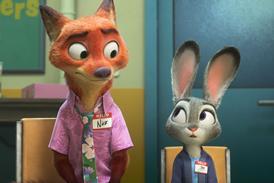There is a temptation to see the merger between Hengameh Panahi's Celluloid Dreams and Jeremy Thomas' HanWay as a commentary on the scary state of today's arthouse business. But the real issue is what it says about the digital future.
The most obvious conclusion to draw from the merger of two of the world's leading film sales businesses is that size counts.
While the coming together of HanWay and Celluloid Dreams has been this month's big talking point, it is not really a shock. Consolidation, economies of scale and vertical integration have been on the agenda of the international industry for some time.
Increased competition drives need to scale up
The creation of the merged company, Dreamachine, comes a year after the purchase of UK sales company Capitol Films by Hollywood entrepreneurs David Bergstein and Ron Tudor.
The need to scale up has been driven by a wide range of factors. One is the increased competition from the studios and the bigger US independents, which have acquired a voracious appetite for local content that was once the preserve of the independent sector. They have been able to use their assured distribution networks and private equity to attract international talent to work with them.
Competing with the big players requires a greater degree of muscle than most independents can muster alone. Some of that muscle comes from the brains and experience concentrated in a consolidated company - and Dreamachine looks like the perfect example.
'Celluloid is definitely a magnet for talent,' says one UK rival. 'Hengameh Panahi is an incredible ambassador for that kind of independent film. And HanWay is a very slick machine.'
But the real key to fighting the bigger players may be tapping private equity, which has funded the US studios to the tune of $9bn. There is plenty of that private capital around, but precious little has gone to the independent sector, which is seen as fragmented and high-risk.
But Peter Watson of HanWay and sister company Recorded Picture Company, says a large independent entity with a strong track record has a lot of potential to unlock capital.
'Private equity is starting to understand the limitations of studio finance and what a bigger independent business with a proven track record can offer,' he says.
Vertical lift-off
Such issues were not traditionally the concern of sales agents, but Dreamachine is going to be more than simply the sum of its parts. If consolidation is the initial talking point, attention will soon turn to the advantages of vertical integration.
Sales agents are transforming into new entities with a much broader interest in film. More and more of the bigger sales agents are looking to take control of distribution and production as well as access to financing. That means having a more crucial role in larger films that have previously been beyond the scope of smaller individual companies.
Panahi says she is 'ambitious ... to work on potentially bigger budget films, but also to be involved in more areas of a film's life than only sales'.
Such vertical integration also allows for much stronger control over how a film is made, financed and distributed - a change that will be crucial with digital distribution networks offering direct access to customers.
Sales agents are also painfully aware of the ever thinner pickings in their traditional hunting grounds. Ask them about their day-to-day existence and they paint a picture of stress-filled and chaotic lives in which it takes Herculean efforts to turn a small profit. They are often working for low commissions of 10%-15%. Sometimes, the commission on sought-after English-language projects can be as low as 5%.
In the analysis of Celluloid and HanWay, the current model of independent film sales - often compared to a cottage industry - is dying or dead. 'What I call the smaller movies I've been putting energy into aren't working any more,' says Panahi.
'They are festival movies and no matter how great they are they can't find distributors. I've tried to sell smaller films for the last three years and they're not sellable anymore. There's no market.'
It is a widely held view. 'People will screw you as low as they can go,' laments another British seller. 'You realise how vulnerable you are. That is why you want to be with bigger people.'
Vincent Maraval of Wild Bunch sums up: '(Panahi) was one of the best. She is still one of the best, but she could not make it profitable.'
Small is beautiful
There is a silver lining, though: some see opportunities in the gap left by the new company's avowed intention to sell fewer smaller titles for theatrical release.
Francois Yon of Films Distribution - a Paris-based company that seems well-positioned to handle some of the auteur titles that might previously have gone to Celluloid - argues persuasively that there is still a market for festival films. 'If you pay the right amount and stick to what the market tells you, there will be no bad surprises,' he says.
'There will be always be smaller independent distributors looking for quality movies that get high exposure in festivals. There are a lot of great world directors who used to be handled by Celluloid who will maybe find a new home.'
Yon reels off Films Distribution titles that have caught buyers' imaginations at recent markets - examples such as Lady Chatterley, Flanders and The Page Turner, all of which he says are 'perfectly coherent' and profitable within their own budgets. 'I don't believe the market is dead for these films,' says Yon. 'I'm the living opposite proof.'
Robert Beeson of Artificial Eye, one of the UK's leading independent distributors, does not expect increasing consolidation in the sales market to affect arthouse buyers in search of festival titles. 'If the films are still being made, producers will find another sales agent,' he says. 'Someone will step up to fill the breach.'
Nevertheless, some film-makers will be anxious at what looks like the backing away of some of the great champions of arthouse and specialist film. Dreamachine's declared interest in English-language fare with wider chances of travelling continues a recent change of direction for the Celluloid Dreams team.
After all, this was a company which saw itself - as its catalogues and promotional material never ceased reminding us - 'the directors' label'.
It is not as simple as that,' says Panahi. The theory is that the smaller films will benefit from being on the same slate as successful bigger films.
'Things are not black and white,' she maintains. 'On one hand you have so-called product, films made by recipes to fit a targeted audience; and on the other you have films done with total freedom without any concern about the audience.
'But we should be in the middle - personal stories packaged with great talent. You can have all that with a very personal movie that is also attractive to the audience.'
Digital opportunities
The fears for arthouse and specialist film must be seen in the context of today's market. The merged company has not lost interest in smaller film - indeed it is consciously not heading off down the genre route as others have. Where it has lost confidence is in the ability of a theatrical-driven market to work for all titles.
Digital, however, is a whole different ball game, and it is in the context of the online world that the Dreamachine merger has to be understood.
On the table at present is a fine back catalogue of more than 500 films. Indeed, it was the potential for the library titles that first got the partners talking.
'Today, the economy for arthouse films is changing towards digital distribution, so for that you need a larger catalogue and a vision of what you want to promote on your own platform,' Panahi says.
Dreamachine also has a clear sense of direction. The company believes in a digital future in which the rules of distribution and finance will be entirely rewritten. 'I think online is the most thrilling development, much more so than DVD or video,' says HanWay's Watson. 'We can reach audiences without having to go through middle men and that means smaller films can be economical again.'
Panahi adds that digital distribution turns today's models on their head. 'In terms of traditional distribution, you have local films and then the big American films. In between you have 1%-3% of other movies, the international independent films,' she says.
The theatrical marketplace is just too limited to make those percentages work for the number of films currently on offer.
'It's not about bringing 30 movies a year to the marketplace, because they will not all fit into this 1%-3% of the market,' says Panahi. 'We'd like to put our energy together and make those select deals solid enough to go into that slice.'
But the niche film will not be lost. 'We would like the smaller movies which don't get into that 1%-3% but are essential for the industry - maybe first-time film-makers and smaller films. They won't be released traditionally and they don't work economically but we can offer them some exposure and digital distribution. You're promoting talent and creating revenues for the rights owners.'
Brave new world of distribution
Sales companies also have to be sensitive to what will and won't work at the box office.
'I was tired of my distributors losing money. I should bring them bigger movies to make them more money so we can prove the independent sector can be healthy,' says Panahi. 'And with those smaller, more niche movies, we can release them digitally and not try to sell them to the usual channels. We have to think about this in the longer term.'
The long-term strategy is being kept under wraps at present but everyone will be aware that digital offers only the potential to reach audiences. Getting them to a site is a different matter.
The impressive library offers a strong start but Dreamachine will be aware that more and potentially larger changes - and further alliances - will need to be in place to really make a big splash in an online world that will soon become as crowded as the real world market place.
By striking out at this stage, companies have acknowledged the challenges of the current market and, more importantly, have made a brave joint step towards what could be a bright future.
Contributors: Geoffrey Macnab, Wendy Mitchell, Michael Gubbins





















No comments yet